Pressurization Fundamentals
By Lloyd A. Keyser
This article originally appeared in the October 1994 issue of Broadcast Engineering magazine. Copyright 1994.
Courtesy: Andrew Corporation
An operational transmission line is critical to broadcast operations, however, it is often overlooked or neglected until it is too late. Performance of air dielectric transmission lines can be greatly reduced when the lines are filled with ambient air, moisture in the air can condense on the inside of the transmission lines. To prevent electrical performance degradation transmission line should be maintained under dry gas pressure. Unfortunately, many of today's transmission lines are not pressurized.
Effects of moisture
Non-pressurized air-filled transmission lines allow moisture entry through the joints. Joint seals have a calculable leak rate, which increases with age. Ballistics penetration (through vandalism) allows copious amounts of water to enter unless the line can be maintained under pressure. Water in a line can cause problems of corrosion, voltage arcing and increased VSWR.
- Corrosion: Without positive dry air pressure, breathing allows moist air to enter. As the temperature drops, it will condense and cause corrosion, which increases attenuation.
- Voltage arcing: Dust-laden moisture deposited on the horizontal surface of an insulator builds a conductive path as the moisture evaporates. As the path arcs over, failure occurs.
- Increased VSWR: Water deposited on horizontal insulators and on the bottom surface of horizontal runs of waveguide causes increased reflected power. It degrades system performance (see Figure 1) and eventually results in transmitter shutdown.
Design considerations
Condensation in transmission lines depends on the amount of moisture in the contained air, expressed as dew point or relative humidity, and the outside ambient air temperature. Dew point is the temperature at which water droplets or ice crystals condense on a colder surface. In other words, when the partial pressure of the water vapor equals the saturation partial pressure of the water, moisture condenses. Relative humidity is the ratio of the actual vapor pressure to the saturated vapor pressure.
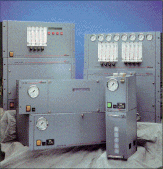 Both dew point and relative humidity are affected by temperature and atmospheric pressure. Dehydrators remove specific amounts of water at a specified maximum relative humidity and temperature to provide air at a specific minimum dew point.
Both dew point and relative humidity are affected by temperature and atmospheric pressure. Dehydrators remove specific amounts of water at a specified maximum relative humidity and temperature to provide air at a specific minimum dew point.
Outside ambient temperature changes require special consideration. The dry gas supply system must be sized to maintain transmission line pressure when the outside temperature drops at rates as high as 50ºF per hour. Likewise, because the transmission line pressure increases when the ambient temperature and solar load on the transmission line increase faster than the leak rate, the transmission line must be protected with a high pressure relief valve.
Excessive pressure drop in feed lines and fittings can create unacceptable dehydrator operation. When the pressure drop of the fitting and/or the tubing approaches the on/off pressure switch differential, the dehydrator will build pressure to that point and shut off. The interval could be seconds, causing the dehydrator to short cycle until the line reaches the desired pressure setting. Short cycling could, over time, saturate the desiccant towers in a pressure swing dehydrator. This is the number one cause of field failure in pressure swing units.
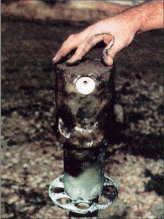 Dust-laden moisture forms a conductive path, as indicated by the burned PTFE. As the path arcs over, transmission line failure occurs.
Dust-laden moisture forms a conductive path, as indicated by the burned PTFE. As the path arcs over, transmission line failure occurs.
The pressure drop in the feed line from the dehydrator to the transmission line depends on its length and diameter. All too often pressurization systems are installed using too small a feed tubing from the dehydrator to the manifold, or manifold to transmission lines. One-quarter-inch feed tubing is not recommended. Most systems can use up to 300 feet of 3/8-inch feed tubing. Large capacity broadcast systems can use up to 500 feet of 1/2-inch feed tubing without degradation.
The magnitude of a pressure drop in the system is directly related to equipment sizing and installation workmanship. Dehydrators are pressure tested at the factory to ensure leak-free operation. Improper or sloppy installation will result in kinks in the lines and compression fitting leaks. Protection of transmission line flanges while the lines are being installed in the towers and buildings is critical. The flanges should not have any nicks, gouges or raised burrs on the edge or surface of the flange. Check that gasket grooves are free of debris and flange seals are smooth with no nicks and cuts. Flange bolts must be evenly torqued to the prescribed values. High-quality installations are low maintenance installations.
Gas supply selection
The gas supply may be from a bottle or, as is usually the case, from a pressurization system. Bottled gases normally used for pressurization are Nitrogen (N2) and Sulfur Hexaflouride (SF6), which have dew points in the range of -70ºF to -100ºF Air, which is the most economical gas, must be dehydrated to remove moisture to an acceptable dew point range of -36ºF to -70ºF. Pressurization systems can be classified as static or dynamic. In static systems, the transmission line is pressurized by a hand pump, or some other means, and the pressurization source is removed.
Transmission lines are not hermetically sealed and will eventually lose pressure in static systems. Therefore, they require periodic recharging. Hand pumps are used on small tight systems and can supply up to 135scf (standard cubic feet) of dry air under the ambient conditions of 40% RH and 70ºF (21ºC) before regeneration is required. Advantages include portability and simplicity. Disadvantages include requiring manual regeneration of the desiccant, and low purge and low system volume.
Dynamic systems incorporate a pressurizing source that provides dry gas on demand. The source may be nitrogen tanks with a regulator or an automatic dehydrator. The source is permanently connected to the transmission line system and recharges it as required.
Nitrogen tanks are mainly used on small tight systems and where mains power is not available. Advantages include a dew point lower than dehydrated air, no power requirements, no moving parts and inexpensive gas. However, there are hidden costs including monitoring tank pressure, ordering additional tanks, bad weather delivery problems, low purge volume, limited capacity (only minutes) in the case of vandalism, and a potentially complex piping installation.
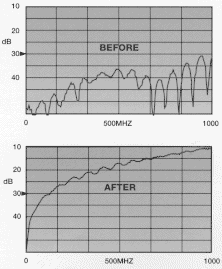 Figure I. Return loss of a length of 3-inch air dielectric cable before and after the introduction of as little as 3ccs to 4ccs of water. The water collects at the bottom connector and causes severe performance degradation.
Figure I. Return loss of a length of 3-inch air dielectric cable before and after the introduction of as little as 3ccs to 4ccs of water. The water collects at the bottom connector and causes severe performance degradation.
Desiccant-type dehydrators are classified as manual, heat or pressure swing regenerative. Manually regenerative dehydrators require frequent inspection and periodic replacement or regeneration of the desiccant. Manual units can supply up to 270scf (7,646 liters) of dry air under the ambient conditions of 40% R.H. and 70ºF (21ºC) before regeneration is required. Their advantages include automatic drying, low power requirements, a 10 to 15 year life expectancy, economy of operation and simple installation. The disadvantages include manual regeneration of the desiccant, power, moving parts, low purge and system volume, and the compressor units generate some noise. However, maintenance is generally more economical than changing nitrogen bottles. Desiccant may be replaced during monthly or quarterly inspections. Saturated desiccant can either be reactivated by baking it for four hours in an ordinary oven at 350ºF (180ºC) during dehydrator down time, or replaced.
Heat regenerative units are used on low volume, low pressure systems only. They are not economical on larger systems due to the complex plumbing, electrical circuitry, and number of components. A heat regenerative unit operates by using two absorbing desiccant containers. Air is passed through one of these containers in which the moisture is absorbed. When the moisture in the desiccant reaches a specified value, the incoming air is switched to the second container. The moisture in the first container is driven out by heat and the process reverses as required.
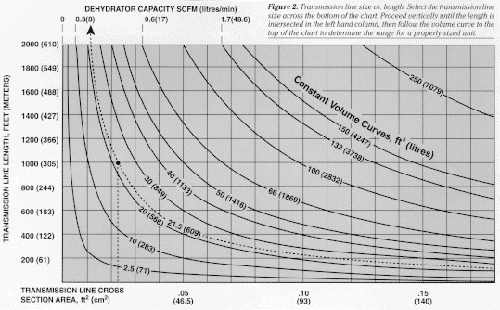
Figure 2. Transmission line size vs. length. Select the transmission line size across the bottom of the chart. Proceed vertically until the length is intersected in the left hand column, then follow the volume curve to the top of the chart to determine the range for a properly sized unit.
The advantages of these units include being light weight and rack-mountable. They also generate less noise and vibration because a small low pressure compressor is used, there is automatic regeneration of the desiccant and relatively low power requirements. Disadvantages include higher total power consumption compared to pressure swing regeneration, a greater number of components for the plumbing and electrical circuitry, and they cannot support a high pressure, high volume system. To overcome system leaks, the unit must be capable of continuous operation.
Pressure swing dehydrators incorporate the principle of moisture separation by desiccant absorption. The units consists of a high pressure compressor and two cylindrical absorption drying chambers switched by a timer control and solenoid-operated valve. The drying chambers are used alternately every 30 seconds. A molecular sieve desiccant is normally used. When the tower alternates, the solenoid valve at the base of the tower opens, allowing 65psi dry air from the drying side to blow the water molecules from the crystalline structure into the atmosphere from the wet side. Approximately two-thirds of the compressed dry air is used to regenerate the tower and the remaining one-third is sent to the system.
The advantages of the pressure swing units include automatic regeneration, a 10 to 15 year life expectancy, economy of operation, dew points in excess of -40ºF, high purge volume, high system volume and simple installation. For small systems, a bypass kit can eliminate short cycling. The disadvantages of these units are the need for power, moving parts and a tendency to create noise.
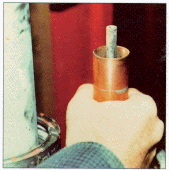 Moisture in a transmission line can result in corrosion that increases attenuation and degrades system performance.
Moisture in a transmission line can result in corrosion that increases attenuation and degrades system performance.
Membrane dryers are new to the industry and offer exceptional reliability and dew points in excess of-50ºF. A patented feedback system generates system dew points in excess of -65ºF. Moisture separation is by the permeation process through an inert maintenance-free fiber material. The advantages of using membrane dryers are increased MTBF calculations due to fewer parts, longer warranty, higher capacity per compressor size with proportionately lower power consumption, and quieter operation. A noise-reduction option is also available. Disadvantages are the need for power, moving parts and some compressor noise.
Proper sizing and installation
Proper sizing of the dehydrator is important to its reliability and ability to provide dry air. A dehydrator that is too small will operate at a high duty cycle and require compressor overhaul in less calendar time. For the manually regenerative units, a desiccant change is needed more frequently, thus increasing costs. A dehydrator that is too large will, in the case of the pressure swing system, short cycle, saturating the towers. Manual and heat regenerative units are unaffected by a smaller system. Properly sized, a dehydrator should operate on a duty cycle of 5% to 10%. This provides maintenance-free operation for up to 10 years without a compressor overhaul.
Improper installation can degrade system performance. Feed line tubing should be neatly dressed and free from kinks. Fittings should be airtight. Transmission line must be purged of any moist air. When pressurized cable is supplied for the installation, the pressure should not be released until installation is finalized. If this is done, only a small amount of purging will be necessary.
During purging, the pressurization unit is connected to one end of the line, while the other other end of the system is is opened. The unit has to operate long enough to allow at least three air volume changes to take place. An alternate method is to pressurize to 81b/in²(55 kPa) and let the air escape after one hour. Repeat this procedure several times, allowing an hour each time for the air to mix.
When choosing a pressurization system supplier, assure yourself of a highly reliable system by obtaining the benefits of program management, a dedicated pressurization engineering department, an environmental laboratory and personnel with a knowledge of the telecommunications requirements. The supplier should also be able to supply a 24-hour loaner dehydrator for an emergency. Remember, a properly selected dehydrator and pressurization system will provide years of trouble-free operation and quality air time.



